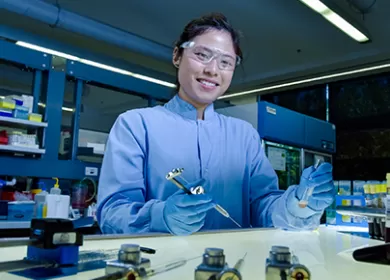Don’t have an account?
Select the donation type you’d like to make
Research study update: Can we take the pain out of blood donation?
First-time donors are often nervous about the needles associated with blood donation.
What was the question?
CoolSense® is a non-invasive device that is used to numb the skin before needle insertion. Having established the safety of the device in a previous study, we wanted to see if CoolSense® was suitable to be used in a donor centre setting and if it reduces any pain associated with needle insertion.
Why is it important?
Fear of needles is a key barrier to donating blood, and a number of donors, particularly first-time donors, report that they’re afraid of the pain associated with donating blood. Utilising a pain-numbing device within Lifeblood may provide a new means to attract new donors and improve the donation experience.
What did we do?
We conducted two trials to test the pain numbing device in the blood donation setting. First, we tested whether the device was feasible for use in our donor centres (feasibility trial), then we tested whether it reduced pain and anxiety in blood donors (efficacy trial).
Feasibility Trial:
Prior to needle insertion, CoolSense® was applied to the skin, with different application times tested to determine the optimum time to reduce pain. Donor centre staff members were asked to provide their views on the device. The trial involved 53 experienced blood donors at one donor centre, with six staff members trained on how to use the device.
Efficacy Trial:
Donors were randomly allocated to one of two groups: a CoolSense® assisted donation, where the device was applied to the skin for up to 30 seconds prior to needle insertion, or a standard donation experience (control group). This trial involved 174 blood donors (both first-time and experienced).
In both the feasibility and efficacy trials, donors completed a pre-donation questionnaire in the waiting area to assess their level of anxiety and anticipated pain. After their donation, donors completed a second questionnaire that asked them to rate their actual level of pain and their level of post-donation anxiety. We were also interested in donors’ perspectives of the device.
What did we find out?
Feasibility trial
Donors who had the CoolSense® device applied for a longer time period (20-30 seconds) reported a larger difference between anticipated pain before the donation and the actual pain experienced, compared to donors who had CoolSense® applied for a shorter duration (10 seconds).
Staff members reported the device was easy to use. Staff reported that CoolSense® may assist new and anxious donors to feel more comfortable with the donation process. There was minimal impact on donor centre workflow when CoolSense® was used.
Efficacy Trial
Donors who used CoolSense® prior to needle insertion reported a greater reduction in pain and anxiety than donors who didn’t use CoolSense®. The majority of donors were supportive of the device, welcoming initiatives to improve donors’ experiences giving blood. Overall, 27% of donors who used CoolSense® reported they would be more likely to donate again if CoolSense® were available, with higher rates among first-time donors.
Most donors reported minimal adverse reactions to the device, such as mild, transient redness of the skin. However, a small number of donors reported symptoms consistent with a cold burn. When we investigated, we found that there was a problem with the functioning of one of the devices that was not immediately obvious to the operators. Concerns were raised about the reliability of the device for use in the blood donation setting, and the decision was made to terminate the trial early. Donor safety and wellbeing is really important to us, so CoolSense® won’t be recommended for normal business practice.
However, this research project did demonstrate that needle pain and donor anxiety could be reduced through innovative approaches, and that donors welcome initiatives like this. The Donor Research team is actively investigating other approaches to improve the donation experience.
Thank you to all of the staff members and donors at Bundoora Donor Centre and Geelong Donor Centre who participated in this study.


